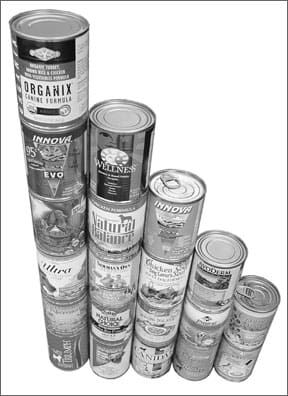How should you choose a canned food for your dog? To start, by looking past its advertising in dog magazines or its front label. We suggest you focus on its ingredient panel, its guaranteed analysis (GA), and finally, on its performance in feeding trials with your dog.
Here is why you have to work a little to find the right food for your dog.
Good ideas get replicated quickly in any competitive market. Products that demonstrate any increased sales performance or popularity are copied and aggressively promoted against the originals.

288
The pet food market is no different. As products that contain top-quality muscle meats, whole grains, and healthy vegetables become increasingly popular, more and more of these foods are offered. That’s great news for our dogs.
The bad news is that along with the increase in genuinely superior products comes an increase in superficially (or artificially) superior products foods that really aren’t all that good. That’s where the marketing department comes in! With glossy studio shots of succulent meats, earthy grains, and fresh, ripe vegetables, professional portraits of flawlessly fit, clean dogs, and a sprinkling of ambiguous verbiage, any dog food can appear to compete with the healthiest products on the market. Especially if you add nominal amounts of the latest “fad” ingredients, blueberries, say, or pomegranate juice, to the product formula. We beg you to put the advertising aside and consider the ingredients themselves.
What’s in the can?
Wet dog foods offer your dog a few advantages over kibble. At levels of 70 to 80 percent moisture, canned dog foods are beneficial to dogs with kidney ailments. All that moisture can help a dog who is on a diet feel full faster (although you should look for low-fat products, as most canned foods are higher in fat than their kibbled counterparts). Canned foods retain their nutrient value longer two years or more, although their contents may change color and texture with time. Dry dog foods, in contrast, experience significant vitamin loss within a year of manufacture (longer for artificially preserved foods, less time for naturally preserved products).
Most significantly, though, the majority of wet foods contain far more animal protein (the dog’s evolutionary staple) than dry foods. Animal proteins are higher in biological value to the dog; they contain more of the amino acids that dogs can’t manufacture themselves, but must consume in their diets (essential amino acids). Though their digestive systems are beautifully able to extract at least some nutrients from just about anything edible, dogs benefit most from meat, especially when it is served up with proportionate amounts of the fat, connective tissue, organs, and even bone that originally came with the meat!
(While we’re on this topic, I’ve been asked several times to identify little pieces of white, bone-like material that a dog owner found in his or her dog’s canned food. If the food contains chicken, the answer is easy; those little flecks are tiny edible pieces of bone. Chicken “frames” (the carcass after the feathers, organs, head, neck, legs, and the breast meat have been mechanically removed) constitutes a hefty percentage of the “chicken” used in pet food. Some muscle meat is attached to the frame, as is a lot of connective tissue. “Chicken” may also contain chicken skin. The legal definition of chicken is “the clean combination of flesh and skin with or without accompanying bone.” Fish “frames” are also common in pet food.)
In addition to being more digestible, wet foods that contain mostly meat are also more palatable to dogs. (Conversely, the more grains and non-meat ingredients are present in a wet food, the lower its palatability.) Best of all, the meat used in canned pet food is usually fresh or frozen; generally, the meats in canned foods are of higher quality that the meats used in dry food.
What’s all this other stuff?
In some wet foods, you may see little more on the ingredients list besides an animal protein source, water or broth (required to help with the physical processing of the material), and the vitamin/mineral sources. The latter are added in amounts that ensure adequate levels of those nutrients even after certain percentages of the vitamins are destroyed by the heat of the sterilization process required for wet foods in cans, trays, and pouches. Often a carb source is used in a nominal way as a thickener/binder. Various types of “gum” (such as guar gum, from the seed of the guar plant, and carrageenan gum, from seaweed) are also common thickeners.
What about all these grains and vegetables and so forth?
Ideally, these extra ingredients have been included for some specific nutritional purpose and benefit. The manufacturer includes a certain amount of blueberries, for example, because of studies that indicate dogs may benefit from the addition of X amount of the unique antioxidants found in the berries.
On the opposite end of the spectrum of rationales for the addition of ingredients is something called “least-cost formulation.” This is just what it sounds like. It’s the method used for determining how a food that contains nutrients at the levels required to sustain dogs can be made as inexpensively as possible. Look at the ingredients labels of the products made by the largest pet food makers in the world and you’ll see what this entails.
Somewhere in the middle of this continuum is the marketing we mentioned in the beginning of this article. If a study comes out suggesting that rose petals can make people live longer, and one pet food that contains rose petals starts selling well, you can bet that rose petals will soon find their way into a number of pet foods.
The use of even the most nutritious “human” food ingredients can be overdone. While it sounds very appetizing (to us!) when a food contains a long list of whole ingredients, including many foods you might find in your refrigerator and cupboards, the more there is of all that in the can, the less room there is for meat. And with canned dog foods, meat should be mainly what it’s about (this goes double for canned cat foods, incidentally).
And you have to keep in mind that dogs have no biological requirement for any carbohydrates; they can thrive without them. Carbohydrate sources are often used in dog food as fillers (and effective binders), although manufacturers will tell you that they have included their carb sources for some nutrient or another, or because they are an important fiber source, helping slow the dog’s digestion and make it more efficient. The latter claims may be true, but the fact remains that all carb sources are less expensive than animal-based proteins and are not required by the dog. We strongly prefer wet dog foods that contain small amounts of grain or no grain at all.
That said, you’ll see that many of the foods that appear on our “top wet foods” list contain grains, veggies, and many other non-necessary ingredients. Here’s why.
What we have attempted to do is to highlight a variety of products that meet our selection criteria for wet dog foods (outlined below). Some of the foods on our lists contain much more animal protein than others; some are extremely high in fat, and other are at the low end of the scale. Some are quite expensive; others may compete in price with bargain grocery-store brands. Some may be found only in specialty pet supply stores in a few states, or by direct order from the manufacturer; some are ubiquitous, and can be purchased in any chain pet supply superstore. What they all have in common is that they are better than most wet dog foods!
Whole Dog Journal’s selection criteria
Here’s how we determine whether a wet food is truly “premium.”
- We eliminate foods containing artificial colors, flavors, or added preservatives.
- We reject foods containing fat or protein not identified by species. “Animal fat” and “meat proteins” are euphemisms for low-quality, low-priced mixed ingredients of uncertain origin.
- We reject any food containing meat by-products or poultry by-products. There is a wide variation in the quality and type of by-products that are available to pet food producers. And there is no way for the average dog owner (or anyone else) to find out, beyond a shadow of a doubt, whether the by-products used are carefully handled, chilled, and used fresh within a day or two of slaughter (as some companies have told us), or the cheapest, lowest-quality material found on the market. There is some, but much less variation in the quality of whole-meat products; they are too expensive to be handled carelessly.
- We eliminate any food containing sugar or other sweetener. Again, a food containing quality meats shouldn’t need additional palatants to entice dogs.
- We look for foods with whole meat, fish, or poultry as the first ingredient (and perhaps the second and third ingredients, too!) on the label. (Just as with food for humans, ingredients are listed on the label by the total weight they contribute to the product.) If water is the first ingredient on a canned food label, that product had better have something else really special going for it.
- If grains or vegetables are used, we look for the use of whole grains and vegetables, rather than a series of reconstituted parts, i.e., “rice”, rather than “rice flour, rice bran, brewer’s rice,” etc.
Go forth and compare
On the following pages, we’ve listed a number of canned dog foods that meet our selection criteria. It’s vitally important that you understand the following points regarding these foods:
- The foods on our list are not the only good foods on the market. Any food that you find that meets our selection criteria, outlined above, is just as good as any of the foods on our list.
- If the variety we describe doesn’t suit your dog’s needs, check its maker’s website or call their toll-free phone number to get information about the other varieties in the same line.
- Quality comes with a price. These foods may be expensive and can be difficult to find, depending on your location. Contact the maker and ask about purchasing options. If the customer service representatives are less than helpful, move on to another product. As you’ll see from our list on the following pages, there are plenty from which to choose.
- We have presented the foods on our list alphabetically. We do not “rank order” foods. We don’t attempt to identify which ones are “best”, because what’s “best” for every dog is different.
- If your dog does not thrive on the food, with a glossy coat, itch-free skin, bright eyes, clear ears, and a happy, alert demeanor, it doesn’t matter whether we like it or not. Take notes, and date them! Sometimes it takes several years of detective work to find products that really suit your dog.
Using the selection criteria we have outlined above, go analyze the food you are currently feeding your dog. If it doesn’t measure up, we encourage you to choose a new food based on quality, as well as what works best for you and your dog in terms of types of ingredients, levels of protein and fat, and local availability and price.






